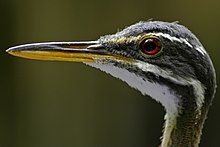Sunbittern
The sunbittern shows both morphological and molecular similarities with the kagu (Rhynochetos jubatus) of New Caledonia, indicating a Gondwanan origin, both species being placed in the clade Eurypygiformes.
[8] Altogether, the two species seem to form a minor Gondwanan lineage which could also include the extinct adzebills and/or the mesites, and is of unclear relation to the Gruiformes proper.
Its remiges however have vividly colored middle webs, which with wings fully spread show bright eyespots in red, yellow, and black.
In the South American subspecies found in lowlands east of the Andes, the upperparts are mainly brown, and the legs and lower mandible are orange-yellow.
The subspecies E. h. meridionalis, has a more restricted distribution, being found along the East Andean slope in south-central Peru, in the lower subtropical zone at altitudes of 800–1,830 m (2,620–6,000 ft).
The final subspecies, E. h. major, is found at various altitudes ranging from southern Guatemala, through Central America and the Chocó to western Ecuador.
[11] The species is found in the humid Neotropical forests, generally with an open understorey and near rivers, streams, ponds or lagoons.
Insects form an important part of the diet, with cockroaches, dragonfly larvae, flies, katydids, water beetles and moths being taken.



